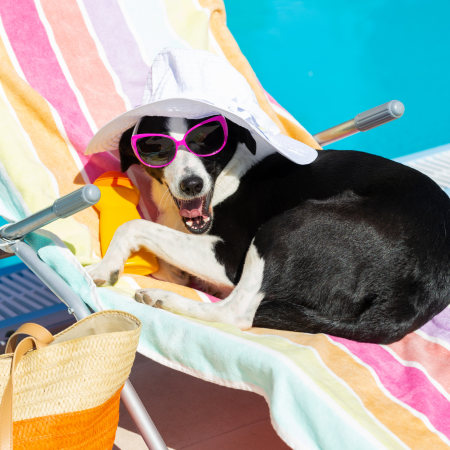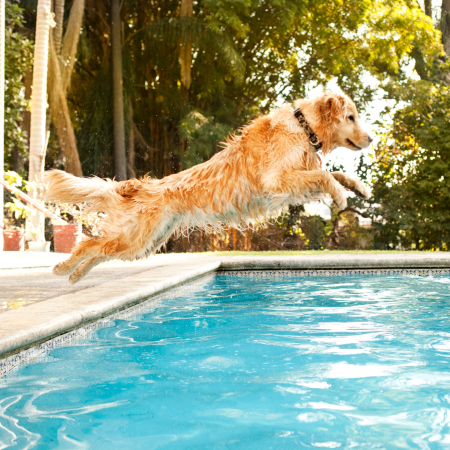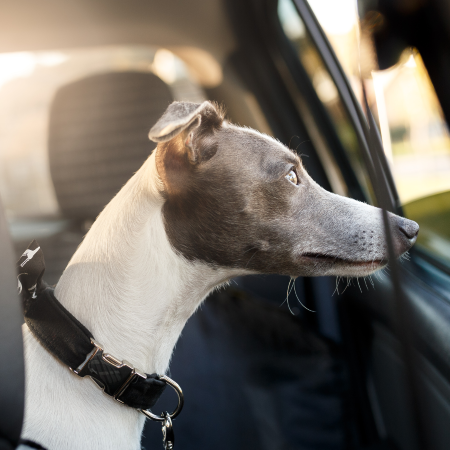When summer arrives, many people are all about vacations, sunshine and travel, (oh my!) Summer's recreational activities with your family are already a blast, but adding your furkids into the mix makes it even better! And there is so many ways to do this!
A thing to consider, sometimes pet safety is forgotten in all the excitement. And as you know, at PetHub our goal is to keep every family's pet safe, happy and HOME for life. So we're sharing the best tips and tricks to ensure the whole family gets the most out of their summer, all while staying safe!
Who let the dogs out, (without Sun Protection)?
The first thing we think about when someone talks about the summer season is time out in the sunshine. As humans we take measures to protect ourselves from the heat and UV rays and our pets need the same consideration!
If your pet has short hair or exposed skin be sure to apply sunscreen designed for pets. (Yes, they make it and its a life saver!) Pets can get sunburned just as easily as you and of course this becomes just as painful. If you aren't using their sunscreen, limit exposure to the sun’s rays, especially during the hottest part of the day and provide your pets with shade if they're not indoors.

The summer heat itself is another factor to be PAW-ware of. Allow your pet to remain indoors during the day. If this isn’t possible then give your pet has plenty of water and shade outside when you’re away or at work. Spray your dog down with water from the hose when you come home for lunch or before you leave for work; every little bit helps. Try cooling treats like something frozen (plain greek yogurt and pet friendly fruit like blueberries is fast and easy) to keep your pet cool and collected.
And don't furget, Never leave your pet in a car unattended, even if it’s only for a minute. Vehicles get very hot very quickly and cracking the windows does very little to lower the temperature.
Heat Stroke Season
For those who love to exercise with their dogs or just enjoy a lively game of fetch, ensure you monitor your pet while doing so. You can learn to recognize when your dog is tired or is becoming overheated. One of the best traits in a dog is their loyalty, but this can become dangerous as they try to keep up with you.
Too much time in the sun with too much activity can result in a dangerous condition called heatstroke, even if you are taking the correct precautions. Dogs are not very good at cooling themselves down as they only pant and don't sweat like humans to. Learning to recognize the signs of heatstroke is an important step in getting your pet to emergency care sooner.
Dogs with shorter snouts, other medical conditions, heavy coats, puppies and older pets are more susceptible to heatstroke. The following symptoms are signs of heatstroke:
- Excessive Panting
- Gums and tongue exhibit a dark or bright red color
- Staggering
- Stupor
- Seizures
- Vomiting
- Coma
If you believe that your pet is suffering from heat stroke, contact a vet immediately! Cool your pet down using cool water. Using cold water may actually be counterproductive as it will constrict the blood vessels and prevent heat from escaping your pet’s body. Do not give your pet ice to eat or ice cold water to drink though small amounts of cool water is fine. Too much water can cause vomiting which will dehydrate your pet.
If you believe your pet has cooled down sufficiently and is not exhibiting symptoms after a certain amount of time do not assume your pet is OK. Secondary conditions and organ damage may still occur; only a vet can give your pet a clean bill of health.

Water Safety for those doggy paddles
Pets can have a great time around water, whether it’s a backyard pool or open water. Here are some things you can do to make your day more enjoyable and safer for your pet.
Just like children pets need constant supervision around water. If you have a swimming pool in your yard it is recommended that you use the same systems that protect children, such as a gate or pool cover and a pool alarm that alerts you if anything has entered the pool.

If your day’s activity includes boating, make sure you outfit your pet with a life preserver fitted just for them. Just like a person they may be great swimmers, but life preservers add an extra measure of protection in an emergency.
Prepare for Parasites
Not only do your pets enjoy coming out during the summer, but so do ticks, fleas and other internal parasites. Talk to your vet about which method of tick and flea prevention is right for your pet.
Make sure to inspect your pet often as they can bring bugs into your home and cause serious medical issues not only for them, but also for your family. If your pet socializes with others, look for signs of illness in the other pets such as diarrhea or excessive scratching, especially if you frequent a puppy or public park.
Avoid Toxins
Summer is the time of year when folks bring out the pesticides, fertilizers, paints and other toxins that may be harmful to our pets. Make sure you store toxins carefully and restrict access to your pets, especially if they are stored in a garage or area where your pet may wander.
Anti-freeze, which is commonly added to radiator water in all seasons, is as dangerous as it is toxic and is sweet to the taste (which can make or fukids want to taste it). If your vehicle is prone to overheating that means it may leak anti-freeze into your garage and driveway. You may want to invest in non-toxic antifreeze; it may be a little more expensive, but worth it to protect your pet’s health.
Travel Safety for the fur family
If you decide to take your pet on vacation in the car make sure they go in a crate or some other type of vehicle restraint. Not only will this protect them in the event of an accident, but will keep you from being distracted as you drive. Remember not to leave them in the vehicle unattended.
When traveling it is also important for your pet to wear an ID tag. If your furry friend decides to wonder off on an adventure of their own and gets lost, the chances of someone finding and helping to reunite you with your pet increases greatly if they are wearing an ID tag.



